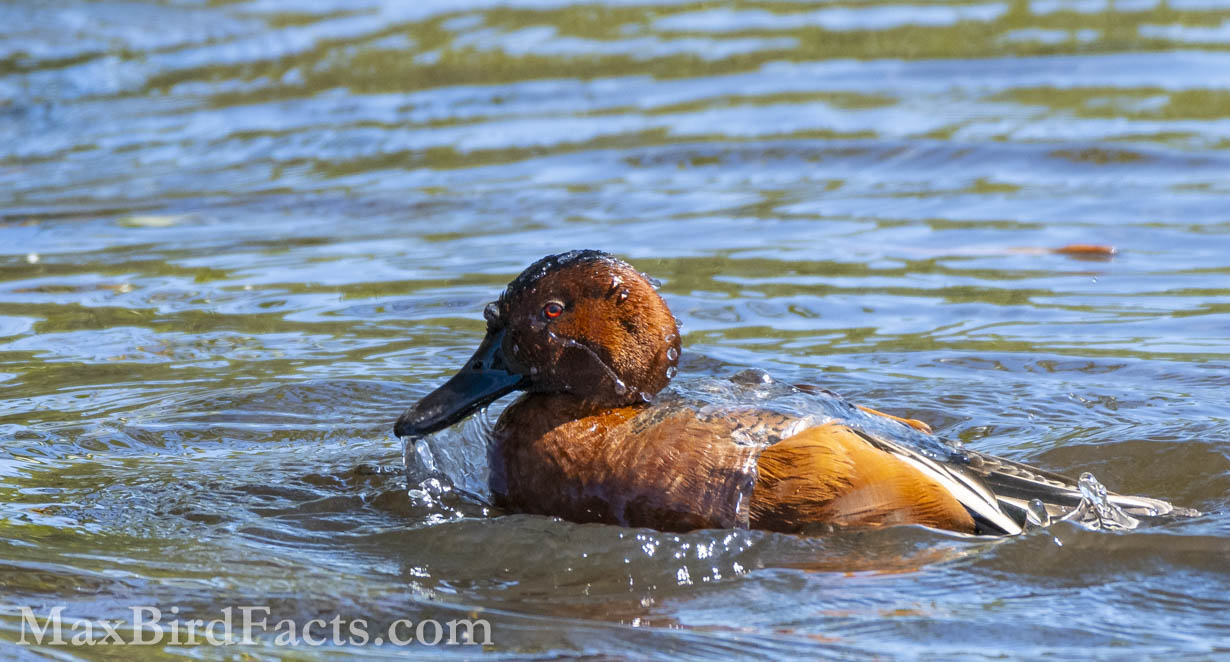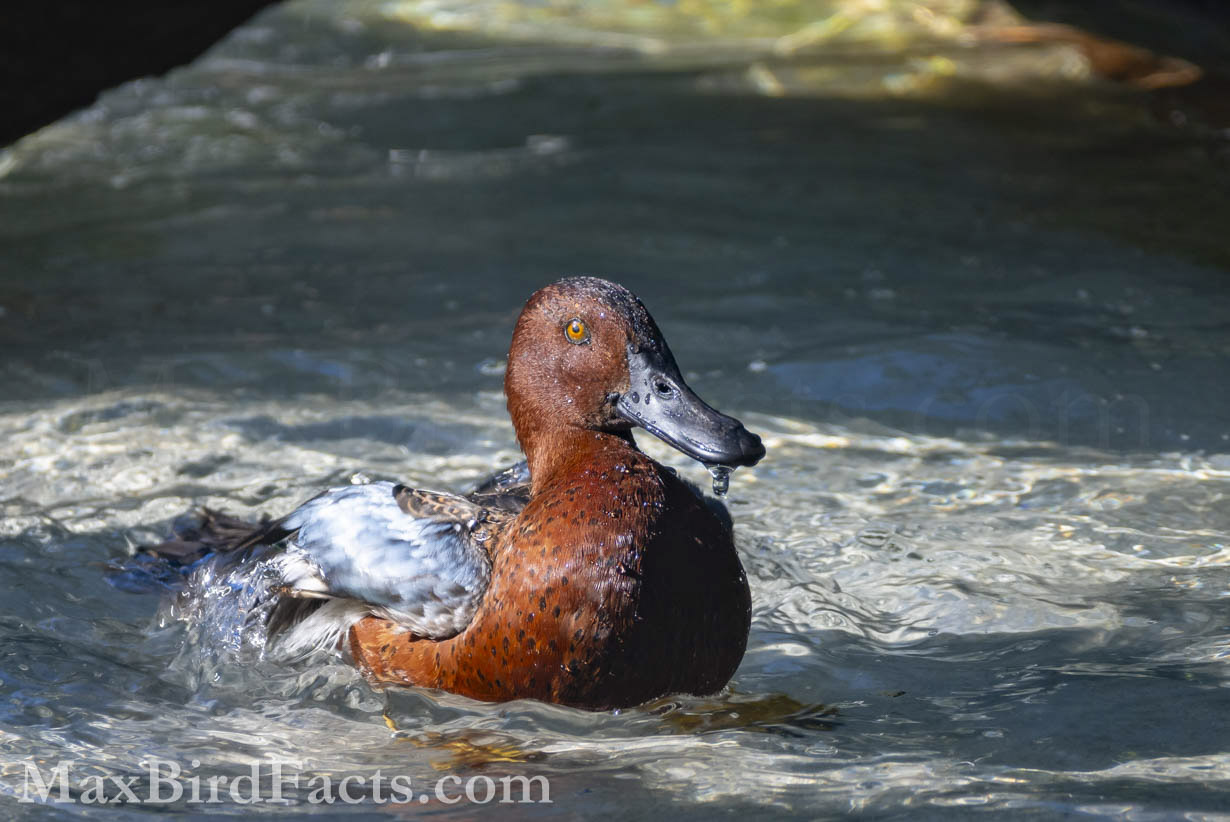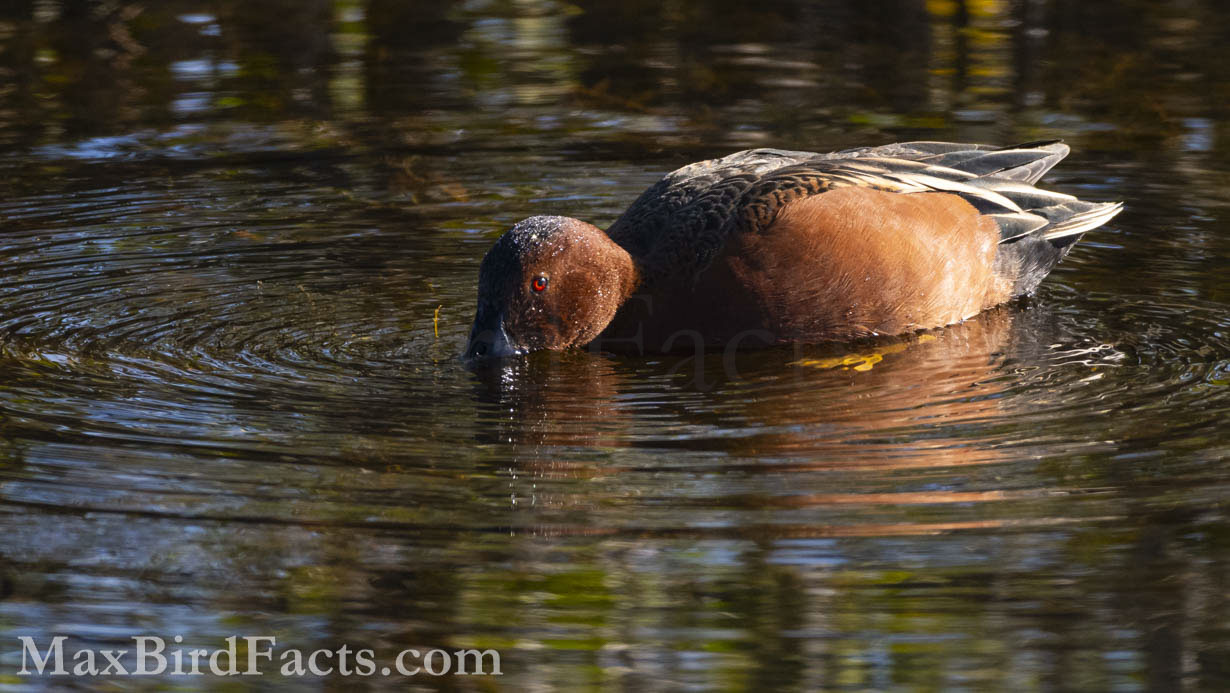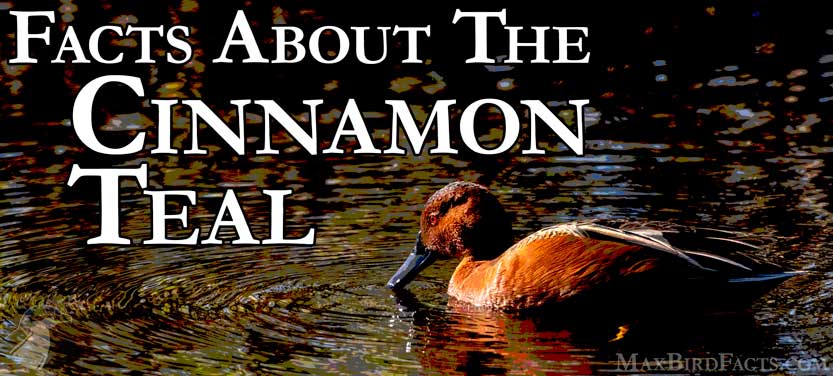The Cinnamon Teal (Spatula cyanoptera) is a reasonably small duck found in the western states of the US during spring and summer. These birds migrate into Mexico and Central and South America for the winter, where some resident populations remain.
Male Cinnamon Teal gives the species their common name, with their beautiful warm, rusty orange-brown, much like the color of the spice. Females, however, are much more drab brown, with the edges of their feathers paler than the rest, giving a scaled appearance.

Both sexes have black beaks, orange legs, and brilliant blue upperwing covers trimmed with white. Males also have striking crimson red eyes, making this a key identifying marker to distinguish them from other species while in nonbreeding plumage.
Now that we know the basic field markings and identifying features let’s dive into seven facts about the Cinnamon Teal!
The Cinnamon Teal’s scientific name, Spatula cyanoptera, means “Blue-winged spoon.”
The two portions of the scientific binomial for the Cinnamon Teal stem from Latin, where Spatula means spoon and cyanoptera can be broken down into two parts: cyan– meaning blue, and –optera, meaning winged.
The genus Spatula has an intriguing history. Initially created in 1822 by Friedrich Boie, it later became lumped with the prominent Anas genus, including species like the Mallard and Northern Pintail.
However, in 2009, genetic research showed that four monophyletic groups were distinct from Anas yet labeled as it. So, ten species, including the Cinnamon Teal, were renamed under the original genus of Spatula, where they remain today.

Cinnamon Teal are omnivorous, dabbling ducks of shallow freshwater or brackish marshes.
Like many other North American duck species, the Cinnamon Teal is a dabbling duck.
Dabbling ducks are birds that feed from the water’s surface, usually resulting in their heads underwater and tails pointing straight upward.
This dabbling behavior isn’t specific to any one genus of ducks but is a shared feeding style among several genera within the duck family, Anatidae. The other primary feeding method among ducks is diving, where the bird swims below the surface, chasing after its prey.
The Cinnamon Teal’s feeding style allows it to feed from a wide array of prey items. These ducks aren’t picky eaters, from crustaceans to seed pods to even the occasional fish.
While they perform the typical dabbling behavior with their tails in the air and heads underwater, Cinnamons often feed by straining surface water through their bill. This is a ubiquitous feeding strategy used by their cousin, the Northern Shoveler (Spatula clypeata), who has a highly specialized beak to strain zooplankton from the water, much like a whale’s baleen.
By doing this, the duck’s eyes stay above the water, allowing them to remain vigilant for predators. Even without the exceptionally well-adapted beak of the Shoveler, Cinnamon Teal prefers this surface dabbling feeding over the typical head-submerged dabbling.

Cinnamon Teal breed in the Western United States.
In North America, the Cinnamon Teal is primarily a breeding season bird, though there are resident populations along coastal California and the US-Mexico border. Its range is relatively broad, covering the entire range of the Central and Pacific Flyways but only going as far north as just into southern Canada.
North America has four primary flyways: Atlantic, Mississippi, Central, and Pacific. The Central Flyway ranges from the Great Plains to the Rocky Mountains, and the Pacific Flyway is from the Rockies to the Pacific Coast.
Outside the United States, the Cinnamon Teal has a mixed set of wintering and residential territories throughout Mexico, Columbia, Ecuador, Peru, Bolivia, Paraguay, Chile, and Argentina.

Like many birds, the Cinnamon Teal primarily migrates during the night. While the method of navigation isn’t entirely known, the current primary theory is that they use celestial navigation.
Research on this subject shows that birds learn the position of stars while young or in the nest. At the point of migration, they use this knowledge to know the direction to fly for their winter or spring territories since the stars rotate throughout the year.
Nocturnal migration also lowers the risk of predation. Predators like the Peregrine Falcon (Falco peregrinus) constitute a significant threat to migratory ducks, but they are visual predators that cannot hunt at night.
Female Cinnamon Teal creates intricate tunnel networks in aquatic vegetation to reach her hidden nest.
The female Cinnamon Teal selects the nest site for herself and her mate, who remains nearby to protect the nest. She typically chooses a location less than one yard from the water in two-foot-tall vegetation with dead growth acting as a roof.
After selecting the site, she creates tunnels through the vegetation to the most secluded zone where she builds the nest. The Cinnamon Teal makes its nest from whatever it has at hand, typically different grasses, rushes, and reeds.
These tunnels confuse would-be predators and allow the female teal to incubate her clutch without worrying about her nest becoming discovered. It also prevents egg thieves from stealing her eggs while she’s out looking for food.
After constructing the nest, the female duck lines the structure with downy feathers to help insulate her eggs during incubation.
The Cinnamon Teal commonly hybridizes with the Blue-winged Teal.
The Cinnamon Teal and Blue-winged Teal (Spatula discors) share the same common trait of having brilliant blue upperwing covers, so it’s no wonder these birds occasionally hybridize.
Females can be tricky to distinguish, though female Cinnamon Teals have a slightly warmer appearance than their Blue-winged counterparts. For this reason, it is challenging to know whether a female duck is a hybrid, though the eye color during breeding season is a valuable clue.
However, when a male Blue-winged x Cinnamon Teal (Spatula discors x cyanoptera) enters into breeding plumage, it shows the red eye and rufous body plumage of its Cinnamon half and the purplish-gray face and some white patches in front of the eye from the Blue-winged.

The Cinnamon Teal also hybridizes with the Nothern Shoveler and Green-winged Teal (Anas crecca).
Through all of these hybridizations, the cinnamon color of the male bird’s plumage seems to be a dominant trait over the other species. At the same time, the facial characteristics of its relatives shine through and dominate over the more plain features of a pure Cinnamon Teal.
Cinnamon Teal occasionally show up in the Eastern United States.
According to virtually any field guide you look at, the official range of the Cinnamon Teal ends at Texas’s Gulf Coast at its easternmost point in the United States. However, these birds winter in southern Mexico and northern South America, meaning they likely conduct nocturnal migrations over the Gulf of Mexico.
So, when a storm blows eastward across the Gulf, these birds sometimes look for a place to land to escape the wind and rain. This is one of the leading theories as to why Florida receives so many odd vagrant species, especially during the migration seasons.
For example, at the time of publishing this article, there are over 669,300 reports of the Cinnamon Teal on eBird in the United States. Of this, only 1,992 records are from Florida; that’s only 0.298% of the total reportings for the US.

While some of these reports are from the state’s interior, most lie along the coasts, particularly the Gulf Coast from Tampa Bay to Fort Myers. This range helps support the theory that these birds are arriving along Florida’s shores via storms in the Gulf of Mexico.
Interestingly, there are continual visitors to specific areas in Florida; one such is at Merritt Island National Wildlife Refuge. A male Cinnamon Teal has been the local celebrity among birders at this location for five years, and the oldest photo of one dating to 2012.
There is the possibility that this is a different male bird each year, but it seems like too much of a coincidence that such a rare bird would continually come to nearly the same point in the refuge year after year. What likely happened is this duck started migrating with a flock of Blue-winged Teal and decided he liked it enough to stick with them.
There are roughly 300,000 Cinnamon Teal in North America, making it the continent’s least populous species of dabbling duck.
While 300,000 birds might seem like a large number, this is only a fraction of the population size of some of their cousins.
The Blue-winged Teal, for example, has a population massing somewhere between four and five million birds. That would mean there are around 17 Cinnamon Teals for every 100 Blue-winged.
Even though the Cinnamon has the lowest population among our dabbling ducks, it still ranks as Least Concern according to the IUCN.
Thankfully, local, state, and federal government bodies have worked to set aside over 1.5 million hectares of wetlands in the western US that are vital to the breeding populations of the Cinnamon Teal.
Hopefully, through diligent conservation and research, the Cinnamon Teal’s population will grow even larger than it is today.

Now We Know 7 Cinnamon Teal Facts!
From the origins and meaning of its scientific binomial to the intricate nest tunnels to their odd hybridizations, the Cinnamon Teal is a truly fascinating bird!
Thank you for taking the time to read this article. If you have ideas or suggestions for topics you would like me to write about in the future, feel free to leave a comment below or email me!
If you enjoyed this article, please subscribe to my email list to be the first to know when I post new articles!
Get Outside & Happy Birding
Max
Discover more from Welcome to MaxBirdFacts.com!!!
Subscribe to get the latest posts sent to your email.
